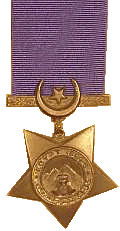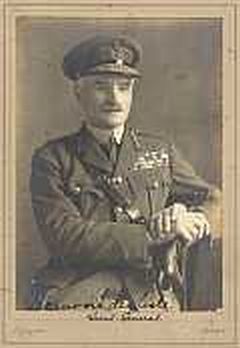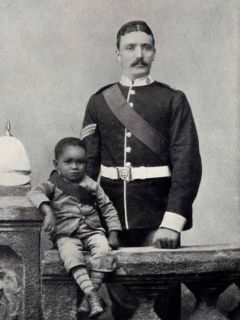|
|
|


James Francis DURHAM
Colours of the Durham Light Infantry 
Infantry Badge  
Jimmy Durham in Cairo 1886 "squatting between Sergeant Major Francies' legs, and supported on the right hand by Colour Sergeant Smith of F. Coy. and on the left by the late Colour Sergeant of E. Coy. "Jimmy" wears the Egypt medal, and even at the early age of 3 has quite a martial air." Quote from the Bugle, 27 October 1899, p.3045 On the second-last day of 1885 they marched to a place between Mozrakeh and Kosheh, where they halted for the night. The next day they took part in the Battle of Ginnis **. Immediately after the battle, the Battalion formed part of the pursuing force. They moved south as far as Kozak, and then held the extreme frontier post of Kosheh, where the men camped for nearly three months. 
Khedive Medal Later when they were stationed in India, the Khedive’s Star was presented to the officers and men of the Battalion who had served in the Egyptian campaign. James Francies Durham, or Jimmy Durham, was born in the Sudan about 1885. His father, from Berber who was a Sheik (this means he acted as an officer in the Dervish army) was killed at the Battle of Ginnis in December 1885. In 1886 Jimmy was with his mother on a boat on the River Nile, attempting to return to their home in Berber, about 500 miles to the south. The boat was attacked by the Mounted Infantry of the 2nd Battalion Durham Light Infantry, under the command of Lieutenant de Lisle. 
Lieutenant de Lisle When within sixty yards of the boat, the command was given to open fire, after three volleys had been poured in, a charge was made, and the boat was seized. The Arabs fled in the darkness leaving only one behind who was badly wounded, and who later had a leg amputated. Alongside the boat was found an infant of about 2 years standing beside a donkey. From the statements of the wounded Arab, it appeared that the child’s father had been killed at the battle of Ginnis, and his widow, with two children, intended to make her way to Berber. As the mounted infantry ran up, the child perfectly undaunted held up its arms to De Lisle to take him up, which he did, and then handed him over to Sergeant Stuart DCM. The attack on the boat changed the whole current of his life. He was taken charge of by the mounted infantry, and was christened James Francies Durham, his real name having been Mustapha. His names were taken from some of the men who looked after him, Private James (Jim) Birley and Sergeant Major Joseph Francies. Frequently, however, his middle name is written as the more usual Francis. 
James Francis Durham aged about 3 with Sgt. Stuart Having recounted how Jimmy had been found, The Bugle (the battalion’s own magazine) went on to describe his early life with the 2nd Battalion. He caused great amusement, by his quaint expressions. At first he could only say “ Bonsy Morto” pointing his finger or a stick at those he addressed. Morto is the Arabic expression to denote death. He was absolutely fearless and would wander round the camp being no respecter of persons. His usual request “ aus laben” which being interpreted means, “ I want milk”. The soldiers treated Jimmy kindly and he was the special favourite of the kind hearted Scotch Sergeant. He performed the long marches seated astride the pommel of Sergeant Stuart’s saddle, on which a blanket was strapped. It was calculated that his birthday would be about January 1885. To English mothers it must seem incredible that a child of two years could talk Arabic and English, ride a horse bare back to water daily, and give a song and dance on a barrack room table. * The 2nd Battalion The Durham Light Infantry. Under the new organisation of the British Army in 1881, the Durham Light Infantry Regiment was created. Consisting of two regular (full-time) battalions (1st and 2nd), two militia (part-time) battalions (3rd and 4th), and five volunteer battalions. The 2nd Battalion was created from the 106th Light Infantry Regiment, which had previously been known as Bombay European Regiment and the 106th Bombay Light Infantry ** The Battle of Ginnis 30th December 1885. The Battle of Ginnis was the last battle that the British Army fought in red uniforms, though The Durham Light Infantry were in khaki, having left their red uniforms in Cairo. The 2nd Battalion The Durham Light Infantry took part in the battle as part of the 1st Brigade. The Digest of Services records the following casualties;
Lance Corporal C. Baker; |